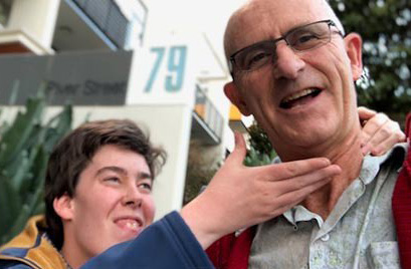Too hot, too cold: Abnormal temperature sensation
Many people with PWS do not feel warm and cold in the way others do. This is a result of the hypothalamic disturbance present in people living with PWS. We might see the person looking cold with blue lips and ice cold hands without complaining, or red in the face and sweating, without saying they feel too hot.
Clothing
People with PWS may need help to learn which clothes are appropriate for the weather or the situation. It is helpful to explain the role of different clothes so that the person can understand and to pre-empt any arguments that might occur once the person has already decided on their outfit for the day.
-
- Separate clothes into types and explain their purpose:
- clothes for wintertime or cold weather: long sleeved t-shirts, sweaters, trousers, shoes etc.
- clothes for summertime or warm weather: short trousers, summer dresses, short sleeved t-shirts, light sweaters, sun hat etc.
- Separate clothes into types and explain their purpose:
Baths and showers
Many people with PWS enjoy long hot, or even cold baths and showers. They may need help to decide on the length of time to stay in the water and how to set the temperature.
You could support the person by:
-
- Giving them a timer to limit how long they are under the shower or in the bathtub.
- Helping them to check the temperature of the water.
- Applying temperature limits to the hot water supply.
- Explaining about the costs of clean water and the costs of warming up the water.
- People with PWS can also enjoy swimming in cold water – especially if the outside temperature is very hot. You can support them to make good decisions about where to swim and for how long.
Risks associated with high and low temperatures
People with PWS are not able to express pain or discomfort in the way that others do and so need support in managing the risks associated with high and low temperatures.
Too hot
Normally when in a hot environment, outdoors or indoors, the small blood vessels in your skin will dilate so that the body can evaporate warmth and you will sweat. In the water you will not notice sweat, but the skin becomes warm.
If you dilate the small vessels in your skin through being in extremely hot water for a long time, there is a risk you will faint (as too much of your blood goes to the skin). This can occur with a very hot bath or shower. So, being in hot water for a long time is a bad idea.
It is important to maintain the bathing temperature of water at 37-38° Celsius (98 – 101° Fahrenheit) for children and 40-45° Celsius (104 – 113° Fahrenheit), for adults. If the water is above 45 -50° Celsius (104 – 122° Fahrenheit) for adults, there is a risk of burning the skin. The sores that develop can become infected, and these will heal slowily, especially if you are overweight.
So, it is recommended to only bathe or shower in warm water, using the temperature guide above, for a maximum of 10 minutes.
It’s the same with saunas. It is very hot in a sauna, and you should not stay there longer than 10 minutes.
Bedding may also pose an issue: as an example, one woman with PWS, was known to use two very warm eiderdowns on her bed during summer, when the room temperature was 30° Celsius. The eiderdowns could only be removed by the carer once she had fallen asleep.
Too cold
If it is cold, the blood vessels will contract to secure and keep the inner organs warm (heart, lungs, brain). Becoming too cold for a prolonged period can lead to hypothermia, which will occur if a person is exposed to temperatures below 10° Celsius or in cold water of less than 20° Celsius for a long time.
The first signs usually include feeling cold and uncontrollable shivering. If the person becomes severely hypothermic, shivering usually stops and they feel exhausted. The skin may appear pale or blue. They may become confused, unsteady on their feet, and start to slur their speech.
In sever hypothermia the heart rate and breathing slows down and the person may fall into a coma, resulting in eventual death if not treated. This sadly, happened to a young man with PWS who ventured into the snow wearing only shorts and a short-sleeved shirt and inappropriate footwear.
Temperature and Fever
People with PWS may not be able to communicate feeling sick or be able to tell you where they have pain. A change in their level of alertness or behaviour may be the first indicators that the person is ill. Not wanting to eat a planned meal may also be a warning sign of illness or pain.
We also know that the opposite reaction can occur, the person speaks about pain but there is no apparent physical cause.
For example when a person is stressed they may talk about feeling feverish, or headaches etc, but you cannot find any physical symptoms or reasons for it. If possible, try to reduce the stress and ask a healthcare professional for support.
Thermal dysregulation or temperature regulation is unpredictable in people with PWS (you need to be vigilant about both hyperthermia and hypothermia) and there may be a lack of febrile response even in the case of a severe infection. High temperature or fever of unknown origin may occur in both children and adults with PWS. Fevers, if not treated early can escalate to cause severe illness requiring intensive care support. People with PWS can also present with an evident infection, but no fever. This situation can lead to the medical response underestimating the problem, especially when the person complains of no pain or discomfort, there is then the risk that the infection can develop into a severe illness.
It is important for medical professionals to be aware of the thermal dysregulation common to people with PWS, to ensure thorough investigations are completed if a person is unwell.
Parents tell us:
-
- My daughter Sophie is 19, and very high functioning. Even so, she comes up with things that prove that no matter how high her IQ, her brain works differently than most. Every morning, Sophie checks the outside temperature before she gets dressed, so she is appropriate for the weather. This morning, we skipped church and hung around in our jammies (pyjamas) till almost noon. She is growing tomato and pepper plants for her garden, and because our backyard is fenced in and pretty isolated, I let her go do her gardening in her pyjamas too. My hubby (husband) decided it would be a nice day for a drive in the country, so when she was done, I asked her to get dressed so we could go for a ride, which she loves to do. It was taking her forever, so I asked what she was doing – she said she was waiting for her phone to boot so she could check the temperature before she got dressed!! (She had just spent half an hour outside). I said you just came in – you know what the weather is like. And she said I CAN’T GET DRESSED WITHOUT THE TEMPERATURE!! We waited…
- James checks the weather too – throughout the day. But if he dresses once, he cannot change. And if he gets dressed later in the day, he wants to sleep in the clothes. I guess he feels they didn’t get worn enough to get washed and can’t put worn clothes back into a drawer.
- Same here, Meghan checks the temperature on her phone every morning before getting dressed. And has to check for the town her school is in, which is not far from where we live.
Summary
Parents and caregivers need to support people living with PWS in dressing appropriately for the weather. Parents and caregivers must remain aware and vigilant about the person’s lack of body temperature changes in response to exertion and illness.
This article was written by IPWSO’s Famcare Board.
2022

International Community
IPWSO was established so that PWS associations, families, clinicians and caregivers around the world could exchange information and support and have a united global voice under one umbrella.
Information for Medical Professionals
The latest medical and scientific research and information, plus guides into common medical issues affecting people with PWS.



